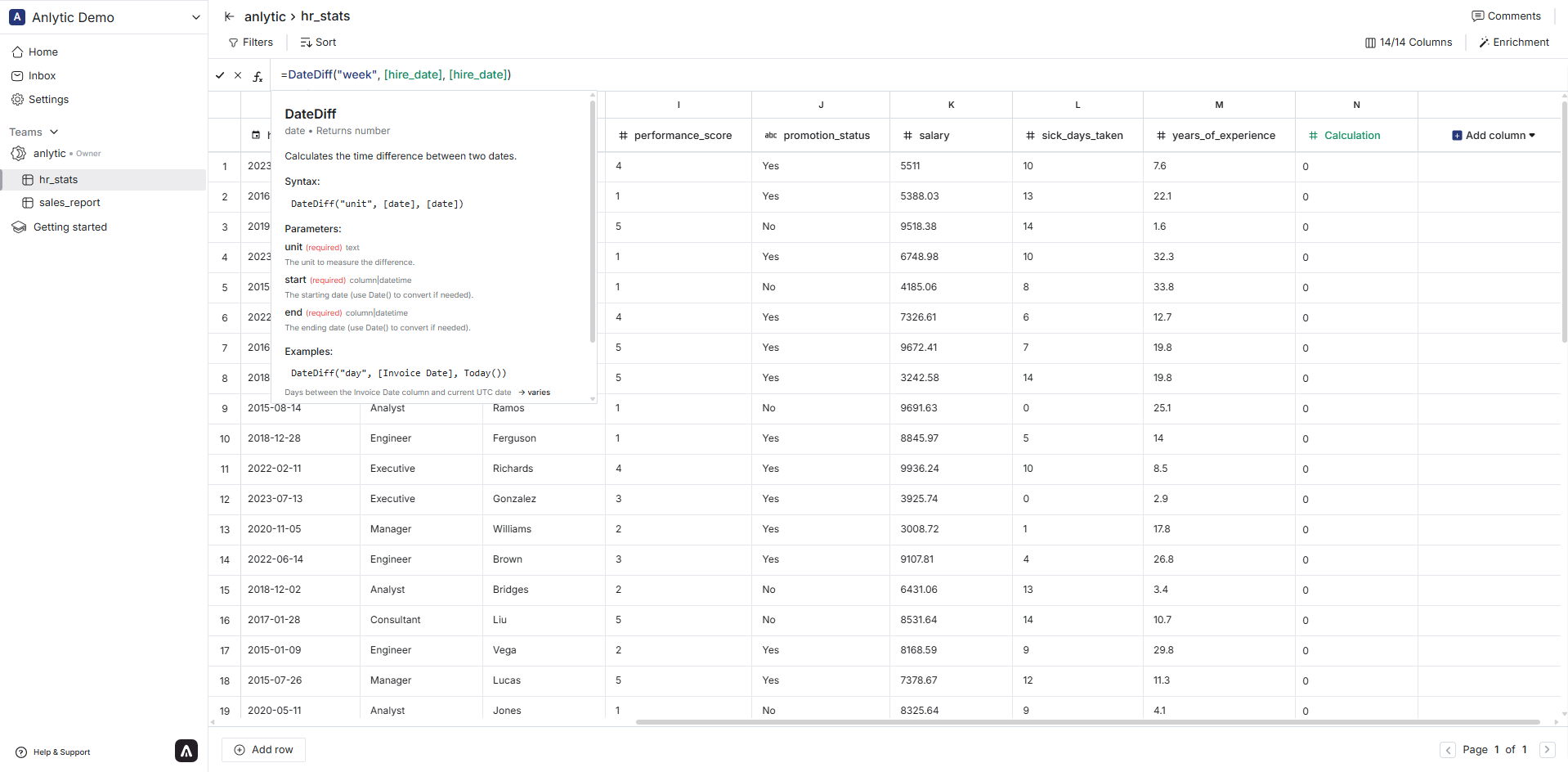Functions Overview
Functions provide powerful formula capabilities for transforming and analyzing your data in real-time. Similar to Excel formulas, functions allow you to create calculated columns that perform operations on your table data.
Accessing Functions
Functions are available within Data Tables in your dashboards. To access functions:
- Navigate to Dashboard → Team
- Create a new Data Table or open an existing one
- The Function Input bar appears at the top of the table view
You can use functions in any data table, whether you're: - Creating a new data table - Opening an existing data table - Viewing a table from a saved dashboard
What are Functions?
Functions are expressions that you can use to:
- Transform date/time values - Extract components, calculate differences, add/subtract time periods
- Manipulate text - Change case, extract substrings, search text
- Perform calculations - Round numbers, calculate square roots, check number properties
- Apply conditional logic - Create if-then rules, handle null values, check ranges
Function Categories
Date Functions
Functions for working with dates and times:
- Extract date parts (Year, Month, Day, Hour, Minute, Second)
- Calculate differences (DateDiff)
- Add or subtract time (DateAdd)
- Truncate dates (DateTrunc)
- Check date ranges (InDateRange, InPriorDateRange)
- Convert timezones (ConvertTimezone)
Examples:
=Year([Order Date])
=DateDiff("day", [Start Date], [End Date])
=DateAdd("month", 1, Today())
Text Functions
Functions for text manipulation:
- Change case (Upper, Lower)
- Extract substrings (Left, Right)
- Search text (Contains)
Examples:
=Upper([Status])
=Left([Product Code], 5)
=Contains([Description], "urgent")
Math Functions
Functions for mathematical operations:
- Round numbers (Int)
- Calculate square roots (Sqrt)
- Check number properties (IsEven, IsOdd, Sign)
Examples:
=Int([Price])
=Sqrt([Area])
=Sign([Balance])
Logical Functions
Functions for conditional logic:
- Conditional branching (If, Switch, Choose)
- Null handling (IsNull, IsNotNull, Coalesce, Zn)
- Range checking (Between, In)
Examples:
=If([Score] > 90, "A", "B")
=Coalesce([Value], 0)
=Between([Date], StartDate, EndDate)
Basic Syntax
All formulas start with an equals sign (=):
=FunctionName(parameter1, parameter2, ...)
Column References
Reference columns by wrapping the column name in square brackets:
=[Column Name]
Example Formula
=DateDiff("day", [Order Date], Today())
This formula:
1. Calls the DateDiff function
2. Uses "day" as the time unit
3. References the [Order Date] column
4. Uses Today() function for the current date
5. Returns the number of days between the order date and today
Using the Function Input

The Function Input appears at the top of your table view and provides:
- Autocomplete - Type
/to see function suggestions - Column Palette - Type
[to select columns visually - Parameter Hints - Hover over functions to see parameter requirements
- Real-time Validation - Errors are highlighted as you type
- Syntax Highlighting - Different colors for functions, columns, and values
Creating a Formula
- Click in the Function Input bar
- Type
=to start a formula - Type a function name (suggestions will appear)
- Fill in parameters using column references or values
- Press Enter or click ✓ to submit
Common Patterns
Calculate Time Differences
=DateDiff("day", [Created At], Today())
=DateDiff("hour", [Start Time], [End Time])
Conditional Logic
=If([Revenue] > 10000, "High", "Low")
=Switch([Status], 1, "Active", 2, "Inactive", "Unknown")
Handle Null Values
=Coalesce([Optional Field], "No value")
=If(IsNull([Value]), 0, [Value])
Text Transformations
=Upper([Status])
=Left([Product Code], 3)
Next Steps
- Function Index - Browse all available functions organized by category
Explore the function categories:
- Date Functions - Complete reference for date and time functions
- Text Functions - Complete reference for text manipulation functions
- Math Functions - Complete reference for mathematical functions
- Logical Functions - Complete reference for conditional logic functions